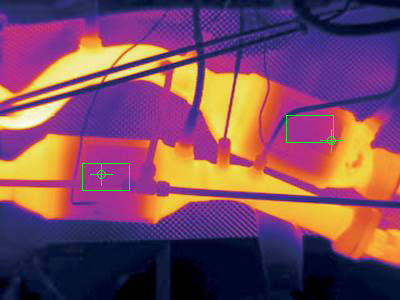The High Speed Data Logger (HSDL) can receive image frames from one or more cameras via GigE interface. Typical applications would include temperature measurements using infrared cameras or dimensional measurements with visible light cameras. For tight synchronization with sampled input channels the camera(s) can be triggered using A/D sampling clock signal. The image data transfer speed from camera to HSDL is limited by either the camera resolution and FPS (frames per second) or by GigE interface max. transfer rate (approx. 100 MB/s).

Camera Thermo Analysis
The HSDL can be configured to store image frames at full camera speed or store only every n-th frame to save disk space, eventually use JPEG compression in order to further reduce size of stored image data.
The HSDL provides tools to perform on-the-fly analysis of the acquired images. The image analysis functions include average pixel value from selected area, distance between two edges or objects or pattern matching (score or count). The image analysis can be performed at full camera frame rate even when storing every n-th image or image storing is completely turned off. If the camera frame rate is lower than that of analog and digital channels, the “missing” frames or image analysis results are replaced with last valid value.
The numerical result of such analysis is then handled as any other analog or digital input channel, i.e. it can be subject to channel math, event detection based on configured limits or it can be displayed in a graph along with other quantities. These channels are called Camera Channels.
The HSDL using one thermography camera to detect temperature at 3 spots within its field of view. When using Xenics Gobi-640-GigE (640×480 pixels, FPS 50 Hz, 16 bit pixel depth) thermography camera the required image transfer rate is 640 x 480 x 50 x 2 = 30.7 MB/s, which is ok as it is within the GigE limit.
In this case the HSDL should be storing 1 month of data, i.e. the required storage space for uncompressed images at full Gobi-640-GigE camera speed would be 30.7 x 86400 x 30 = 80 TB of raw data. This amount of disk space is beyond our standard HSDL architecture. One way of reducing the amount of data is by using image compression. You can configure the HSDL to encode image frames into JPEG format before storing, which will reduce the amount of necessary disk space to approx. 10% compared to raw data. The disadvantage of JPEG compression is its limited pixel depth to 8 bits per pixel, loss of fine detail and introduction of compression artifacts (http://en.wikipedia.org/wiki/Jpeg#Effects_of_JPEG_compression). Considering that the temperature of the technology imaged by the camera will have a large time constant, saving one image every 1 second would be sufficient. This leads to about 1.6 GB of disk space, which is within the disk capacity of HSDL standard architecture.
There will be 3 channels, where each of the channels will be associated with one small rectangular area within the camera image. The value of each channel will be equal to the average temperature across each of the areas. The number of areas, their size and position as well as calculated quantity is user selectable. The channel values will be calculated every one image frame received from camera, i.e. 50 times per second.
The stored image frames can be viewed both on-line and off-line, synchronously with analog and digital data. In the off-line mode the image frames can be viewed as still images or played as a video with adjustable playback speed.
